Unit IV
Strategic Alternatives for Growth
Strategic Alternatives for Growth
Alternative Growth Strategy
The following products-market matrix shows five growth options. The first is to enter the existing product market. Companies may want to attract customers from their competitors while increasing their use by existing customers. The second option is to expand the product while staying in the current market. Therefore, companies that provide cleaning services to healthcare facilities may extend to overseeing other healthcare functions, such as purchasing and building maintenance. The third option is to apply the same product to new markets. Cleaning companies have the potential to extend cleaning services to other industries. The fourth option is diversification as companies enter unfamiliar areas, new products and new markets. These diversification movements represent both growth and revitalization opportunities and the great risk of running an unfamiliar business in new situations. Finally, a strategic option that is not covered within the product market is vertical integration. Some publishers are back-integrating into paper and wood products. Other companies such as Nike and Levi Strauss are positively integrating into retail.
Growth of existing market
Increasing market share can be one of the most logical ways to grow. It focuses on, for example, tactical behaviour, providing higher value to customers (see Customer Value and Value Map on this web page), or selected competitors and their customers. It can be achieved by. However, attempts to increase market share are likely to have a direct impact on competitors, which may respond to limit the effectiveness of market share growth strategies. Alternatives that attempt to increase usage among current customers are usually less threatening to competitors. You can increase usage in two ways by increasing usage frequency or usage. In each case, there are several effective approaches (for example, providing reminder communication, positioning regular or frequent use, facilitating use, providing incentives, reducing unwanted consequences from frequent use, branding). Activation, new application for existing product users).
Product Development
Product development can occur in a variety of ways and can help you distinguish between them. This includes adding product features, developing new generation products, and developing new products for existing markets. Adding functionality to a company's current product can dramatically change the dynamics of competition if it is the right one. New generation products can also lead to significant growth. However, established participants face two forces that impede innovation. First, even if a new technology succeeds, it often requires a large investment just to maintain the same level of sales and profits. New technologies can also add time and money and create problems that reduce customer acceptance. Second, existing market participants need to focus on improving the cost, quality, and service of their existing products. This saves little time and effort in exploring entirely new technologies. Established competitors face these two forces limiting innovation, but outsiders have nothing to lose and much to gain from pursuing innovation that disrupts the market.
Perhaps the most obvious way to grow is to open up new markets by duplicating business operations. As the market expands, you will be able to use the same expertise and technology, and in some cases the same plants and operations facilities. Therefore, there is a synergistic effect, which can result in reduced investment and operating costs. Of course, market development is based on the premise that the business is already successful. Geographical expansion may include changes from rural to regional and national operations. Success involves significant investments in logistics, distribution infrastructure, organizational building and adaptation. To limit investment, this extension can be implemented through partnerships or mergers by connecting to partners who already have the ability to market more broadly. Companies can also grow to reach new market segments. The key to discovering new markets is to consider various segmentation variables. Looking at the market in another way may reveal useful segments. Identifying underserved segments is especially helpful.
Diversification Including New Products and New Markets
Diversification is a strategy to enter a product market that is different from the market that a company is currently working on. Diversification can be categorized into those that are relevant to the core business and those that are not. In the relevant diversification, the new business areas have meaningful commonalities that have the potential to create economies of scale. Or synergistic effects based on the exchange of assets and capabilities. The resulting integrated business should be able to achieve higher return on investment by increasing revenue, reducing costs, or reducing investment. Meaningful commonalities include sharing R & D, distribution channels, operating systems, brand names, manufacturing facilities, offices, or warehouses. Unrelated diversification may still be justified, but it requires different rationality.
Vertical integration represents another potential growth direction. Forward integration occurs when an enterprise moves downstream with respect to a product flow. For example, when a manufacturer buys a retailer. Backward integration is heading upstream, for example, manufacturers purchasing raw material sources. According to David Aaker, a good way to understand when to consider vertical integration and how to evaluate it is to look at the possible benefits and costs of a vertical integration strategy. Vertical integration potentially provides access to supply or demand, control of quality of products or services, and / or entry into attractive business areas, but at the same time with the risk of managing very different businesses. It reduces strategic flexibility. There are several options for integration, including long-term contracts, exclusive trading contracts, asset ownership, joint ventures, strategic alliances, technology licenses, and franchises.
Stable combinations & inter-national strategies
In general, stable strategies are risk-averse companies, usually small businesses, or if market conditions are not good and the company is happy with its performance, it will not make a big difference in business operations. Also, slow-changing and reluctant companies believe that stable strategies are safe and are not looking for other options.
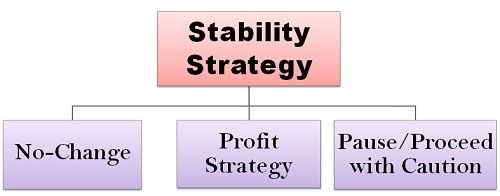
There are three types of stability strategies:
To better understand your stability strategy, run the following examples in the context of customer groups, customer features, and alternative technologies.
Publishers offer special services to educational institutions, apart from consumer sales through market intermediaries, with the aim of facilitating bulk purchases.
Electronics companies provide better after-sales service to their customers in order to satisfy them and improve their product image.
Biscuit manufacturers are improving existing technologies to achieve efficient productivity.
In all of the above examples, the company hasn't made any major changes to its operations and uses the same technology to deliver the same products to the same customers.
Reduction strategy
In other words, if a company decides to eliminate activity through a significant reduction in business operations, it is called a reduction strategy, either individually or collectively, in terms of customer groups, customer capabilities, and alternative technologies.
The company can either restructure or shut down its business in order to rejuvenate its financial position. There are three types of mitigation strategies:
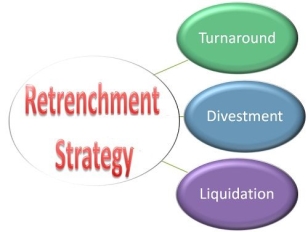
Retrenchment Strategy
Expansion strategy
Definition: Expansion strategies are adopted when an organization seeks to achieve high growth compared to past achievements. In other words, if a company aims for significant growth by expanding its business operations individually or jointly in terms of customer groups, customer capabilities, and alternative technologies, it follows an expansion strategy.
Reasons for expansion may be survival, increased profits, increased fame, economies of scale, increased market share, social benefits, etc. Expansion strategies are adopted by companies with highly accomplished and recognized managers. Their purpose is to grow regardless of risk or disability.
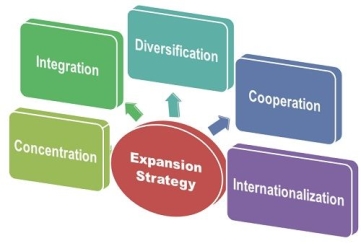
Expansion Strategy
Companies can follow one of five expansion strategies to achieve that goal.
Grand strategy
Definition: A grand strategy is a company-level strategy designed to identify a company's choices in terms of the direction it follows to achieve its set goals. Simply put, it involves the decision to choose a long-term plan from the set of available options. Grand strategy is also called master strategy or corporate strategy.
There are four grand strategic alternatives that an organization can follow to achieve its long-term goals.
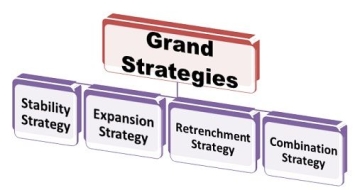
Grand Strategy
Strategy without change
Definition: As the name itself implies, an unchanged strategy is a stable strategy that an organization follows when it aims to maintain its current business definition. Simply put, the decision to do nothing new and continue existing business operations and practices is called an unchanged strategy.
If the environment appears to be stable, that is, if there are no threats from competitors, financial turmoil, or changes in strengths and weaknesses, the company can decide to continue its current position. Therefore, by analyzing both the internal and external environments, the enterprise may decide to continue with its current strategy.
Definition: A clearing strategy is the most offensive strategy adopted by an organization, including the sale of assets and the final closure or termination of business operations.
This is the most important and last resort of reduction, as it has serious consequences such as a sense of failure, loss of future opportunities, poor market image and loss of employee employment.
Combination strategy
Such strategies are implemented when a corporation is large and sophisticated, exists in several industries, and consists of multiple businesses that serve different purposes. Run the subsequent example to raised understand your combination strategy.
* Infant diaper manufacturers are expanding their diaper offerings for infants (stability) and at an equivalent time manufacturing diapers for the elderly, covering other market segments (expansion). To focus more on the diaper division, the corporate plans to shut the wipes division and allocate resources to the foremost profitable division (reduction).
In the example above, the corporate follows all three grand strategies with the goal of improving performance. Strategists got to be very careful when choosing a mixture strategy, as they involve environmental scrutiny and therefore the challenges faced by each business operation. Combined strategies are often executed simultaneously or in sequence.
Key takeaways:
Choice of Strategies
Introduction
Factors Affecting Strategic Choices
This stage involves narrowing down the many options available for the most viable strategy. GAP analysis is used by the manager to determine this manageable number of a viable strategy.
They visualize the state of the future business to identify suitable alternatives. Even one or more business aspects relate to the alternatives available to choose the most strategic ones.
Strategic alternatives at the enterprise level are stability, expansion, combination, and reduction. On the business level, on the other hand, cost leadership and centralized business strategy.
Analysis of strategic alternatives
Here, the selected choices are analyzed based on specific factors called selection factors. These factors provide the criteria for evaluating these alternatives. Such factors are: –
Evaluation of strategic alternatives
Appropriate assessment of all factors is done to identify the ability of an organization to help achieve its goals. This step summarizes previously performed analyzes based on objective and subjective factors. Appropriate evaluations from different aspects of different alternatives are performed to reach the most appropriate one.
Make strategic choices
Finally, strategic choices are made after an evaluation that gives a clear idea of which is most appropriate under existing conditions. One or more strategies are selected and a blueprint is created that describes the operating conditions of these strategies. Emergency response strategies are also developed to address unexpected scenarios.
Goal setting and strategic selection
Business planning is the process that large and small companies use to determine behavioural policies that lead to increased revenue and increased profits. In short, it's the path to success. Two key aspects of the business planning process are setting goals, also referred to as goals, and making strategic choices to realize these goals.
Defined Purpose
The purpose is to describe the future outlook for what the employer is trying to achieve. These can be quantified. For example, next year's sales will increase by 20%. However, many goals are not expressed numerically, such as setting goals to improve morale in the sales and marketing departments. Companies usually have short-term goals (goals that will be achieved next year) and long-term goals that can be overlooked for more than five years.
Purpose
By setting goals, you can measure the progress of your company. For example, you can compare the number of units you plan to sell with the number of units that actually occur to understand why the positive or negative difference is behind. For a successful business, all members of management and staff must work together. By setting goals and communicating them to members of your organization, everyone can focus on the highest priority tasks and work under the same assumptions about the future of the company. Business owners don't want marketing managers to set overly optimistic goals, but production departments expect weak demand for the company's products.
Defined Strategic Choice
Every company has a certain amount of resources. Among them are financial resources, human resources, production capacity and distribution channels. Strategic choice is a specific step that an enterprise will take to deploy these resources. Strategic choices include determining which products and services to sell, where to sell them, how to sell them, and the target market in which they are sold. If the goal is to gain market share, the strategic choice may be to gain competitors. Another strategic choice may be to focus on trade fair sales rather than using advertising to reach potential customers.
Importance of strategic choice
The success or failure of a business depends largely on the strategic choices made by the owner. Spending a great deal of time and money on deploying a product that turns out to be very limited in the market is an example of a bad strategic choice. Predicting changes in consumer preferences and deploying services that take advantage of those changes before competitors is an example of a good strategic choice. Business strategy development takes into account that all companies have to deal with limited resources to some extent. The most successful companies can allocate scarce resources to projects that have the best positive impact on revenue growth and increased productivity and efficiency, and may increase profit margins.
Relationship with purpose
The goal describes where the company wants to go. The strategy shows how to get there. The restaurant may be aiming to increase the number of customers servicing by 12% next year. Several different strategies can be adopted to move the company towards this goal. For example, you can simplify your kitchen operations so you can bring your meals to meals faster. Alternatively, the restaurant can offer special discounts on late nights when the business is usually late.
Generic Business Strategies
Definition of "general strategy"
Definition: Michael Porter developed in 1980 three general strategies that businesses can use to gain a competitive advantage. These three are cost leadership, differentiation, and focus.
Description: Cost leadership strategies advocate gaining a competitive advantage because the production cost of a product or service is the lowest. The lowest cost does not have to mean the lowest price. Costs are removed from all links in the value chain, including production, marketing, and waste. Products may still be competitively priced (same price as other products), but due to low production costs, the company keeps itself in lean time and invests more in the entire business. You can do.
An example is the TPS system developed by Toyota Motor Corporation. The TPS system aims to reduce costs company-wide, but Toyota cars are priced at about the same level as American and other Japanese cars.
A “differentiation” strategy involves creating differentiated products for different segments. Different products are branded and promoted in different ways, each with a different level of functionality, allowing businesses to "insensitive" prices and charge premiums and above based on different prices. This strategy also provides hedging against different markets and product lifecycles, allowing cash flow to be secured even if some products decline and others grow or mature.
A prime example of this strategy is the Hindustan liver, which focuses on FMCG and offers a variety of products within the soap categories of different segments. Such a technique requires strong segmentation, marketing and branding skills.
A "focus" strategy involves focusing on a narrowly defined segment of the market, also known as a "niche" segment. For example, Porsche likes fast and expensive cars and sells them to specific segments that they can afford. Companies in niche markets have customers who can understand their indulgence, appreciate them, and pay a premium. Competitive advantages due to cost or differentiation are created specifically for the niche. But the risk is that the niche may not grow or disappear over time. Every business needs to find a strategy that will enable them to achieve a competitive advantage in the market. The choice of strategy is based on the strengths and weaknesses of the company's products and the desired position in the customer's mind. The best strategy is to leverage your company's strengths for maximum profit and maximum return on investment.
Companies seek to gain a competitive advantage by offering consumers better for their money. It may be the lowest price on the market or offer a product with better profits to justify the higher price.
Michael Porter, a professor at Harvard graduate school, wrote several well-known books on competitive business strategies. His work on general strategy is popular all over the world and is used by managers of all levels. Porter believed that in order for a company to win the competition and survive in the long run, it needed to identify and implement a clear strategy.
Porter's general strategy is as follows:
Cost leadership strategies work when a company can produce a product at the lowest cost in the industry. This strategy is commonly used in markets where the products are not distinctly different from each other. They are "standard" products in a wide range of markets, are frequently purchased and widely accepted by most consumers.
To become a cost leader, companies strive to reach the lowest production costs with the lowest distribution costs so that they can offer the cheapest prices on the market. At the lowest price, the company wants to dominate the market by attracting the most buyers and kicking out competitors.
Productivity: Study the processes that use the workforce and find ways to increase productivity and efficiency.
Bargaining power: One way to reduce production costs is to leverage economies of scale. The higher the volume, the more companies can negotiate lower prices and lower shipping costs from material suppliers.
Technology: Technology is improving rapidly and companies need to invest in the latest innovations to stay competitive.
Distribution: Like technology, distribution methods are constantly evolving. Companies need to continually analyze changes in distribution costs to find the lowest cost to transport goods.
Manufacturing method: Reducing manufacturing costs is an ongoing process. For example, implementing just-in-time inventory management for raw materials asset.
Differentiation strategies got to offer products with unique characteristics that buyers believe are valuable and willing to pay more. If consumers find these unique characteristics valuable, the corporate can charge a premium price for his or her products.
Ideally, the premium price is quite enough to offset the increase in production costs and make an inexpensive profit for the corporate.
Successful companies with a differentiated generic marketing strategy require talented and artistic development staff. These people got to have the power to research the market and identify the power to be captivated by potential buyers, attract consumers and be willing to pay more for his or her products. There is.
Having a singular product isn't the top of the story. Implementing a differentiating strategy requires a sales team with the talents to effectively communicate the unique characteristics of the merchandise and convince consumers that they're receiving more value. At an equivalent time, marketing campaigns got to promote and establish the corporate as a reputable company known for its top quality and innovative products.
Differentiation strategies carry some risks. Losing market share doesn't leave competitors idle. they're going to find how to imitate the merchandise and launch their own differentiation campaign.
Another risk is changing consumer tastes. When competitors introduce other features that catch the attention of the customer, they will diminish the unique product characteristics that capture the consumer's attention directly.
Focus on cost
Cost-focused strategies specialise in limited market segments or specific niches. Companies got to understand the individuality of their market and therefore the unique needs of their particular customers.
Companies pursuing cost-focused strategies are taking risks by abandoning the mass market. that specialize in a specific demographic may develop a loyal pool of consumers, but the corporate bases its property on alittle group of buyers. Features that appeal to the present niche market might not appeal to the broader market.
Focus of differentiation
Similar to cost-focused strategies, the differentiated approach is aimed toward narrow niche markets. during this case, the corporate finds unique features in its products that appeal to a specific customer group.
However, the corporate relies on the consumption habits of a little group of consumers for its profits. If the group's hobbies change, it'll be difficult to vary direction to start out selling to the mass market.
Successful differentiation focus strategies require developing strong brand loyalty from customers and constantly finding unique capabilities to remain before the competition.
The first step in choosing your company's strategy is to perform a SWOT analysis of your business. Additionally, to highlighting market opportunities and threats, this analysis identifies the strengths and weaknesses of the corporate.
To fully understand the market, Porter has developed another model referred to as Five Forces Analysis. This analysis looks at the factors that negatively impact your business's competitiveness and profitability. Those factors are
SWOT and Five Forces analysis can assist you identify which of those common business strategies is best for your company.
Key takeaways:
It provides a way to compare a number of business activities with each other, establish priorities, and determine winners and losers.
Developing an organizational portfolio plan is the final stage of the strategic planning process. Strategic portfolio analysis assumes that most organizations are actually a portfolio of companies at a given point in time.
For example, an electronics manufacturer may have multiple product lines (TVs, refrigerators, stereos, washing machines, dryers, etc.) and two divisions (home appliances and industrial appliances). In other words, a corporate portfolio consists of all the businesses, product lines, departments, or other components of a parent multi-industry company.
If you have abundant resources and cash and each group is experiencing "growth" and "profit", managing such a business group will be a little easier. Unfortunately, it is no longer feasible to provide more and more budgets to all business groups [potentially Strategic Business Units (SBUs)] each year.
Strategic portfolio analysis has its primary purpose of optimally allocating funding sources among the various business activities that make up a diverse corporate portfolio. In addition, top management can help companies decide what business activities they should do, how they should evaluate the performance of different business units, and who should manage these departments.
Many have not experienced growth and are increasingly lacking in profits and / or resources (financial and non-financial). In these situations, strategic portfolio analysis helps management make choices in the form of master and program strategies, including competitive and financial strategies.
General Electric and the Boston Consulting Group made pioneering contributions to this approach to strategic portfolio analysis. General Electric has introduced the concept of dividing business activities into SBUs with similar characteristics in relation to the product life cycle.
The Boston Consulting Group (BCG) has contributed significantly to the development and dissemination of this analytical method. The BCG approach consists of a wide variety of products and market shares with different growth rates, exploring investment strategies and allocating resources for long-term optimization of the enterprise. -Execution profit. At the heart of strategic portfolio theory is the growth share matrix shown below.
The matrix above provides a scheme for roughly classifying a company's business according to its strategic needs (including cash requirements). The horizontal axis shows the relative market share held by the various SBUs and is expressed as the percentage of each SBU's share held by a major competitor in a particular market. The vertical axis shows the growth rate of various markets in which companies compete.
A company may at any time consist of multiple SBUs that fit into each of the four categories shown in the matrix above. STARS offers the company the best profits and growth opportunities because it has the advantage of growing rapidly and already gaining a high market share.
BCG believes that the QUESTION MARK SBU has only two viable strategies: to grow the SBU into a star or to sell (remove) it. DOGS (Apologies to fellow dog lovers) are the first choice for sale as they have little hope for the future and may not even pay in their own way.
In contrast, due to its high market share in low-growth areas, CASH COWS provides the funds needed to pay dividends and debt, recover overheads, and fund investments in other growth areas. Ideal to do.
The matrix above shows how companies in two well-known industries are categorized using a growth share approach. However, in reality, the portfolio matrix is used to classify different businesses for resource allocation purposes.
Categorizing a business into a portfolio is often a daunting task. However, proper classification is essential to success in the industry. Again, in order to optimize resource allocation, developing a healthy portfolio usually requires considerable analysis and negotiation by managers and staff at both the enterprise and business levels.
For a balanced portfolio, the cash required for the question mark should be approximately equal to the cash produced by the cow. This equilibrium limits the number of question marks that must be included in the portfolio. Strategic portfolio analysis has many variants other than the BCG Matrix. These are Market Strategy (PIMS), Experience or Learning Curve, 9-Cell General Electrical Matrix, Lifecycle Portfolio Matrix, McKinsey Framework, Directional Policy Matrix (DPM), Risk Matrix, DPM, and Risk Matrix (3D). The effect on profits. Matrix, portfolio and risk) etc.
Strategic portfolio planning helps establish performance goals for different business units. Theory suggests that the four types of businesses in the Growth Share Matrix should be valued in completely different ways in terms of growth and profitability. This will help guide you in choosing a manager to lead your business in your company's portfolio.
Overview of Implementation Aspects
Definition: Strategy implementation refers to the execution of plans and strategies to achieve the organization's long-term goals. Transform your strategy into organizational movements and behaviours to achieve your goals.
Simply put, implementing a strategy is a way for a company to develop, use, and integrate its structure, culture, resources, personnel, and control systems to follow a strategy that gives it an edge over other competitors in the market is.
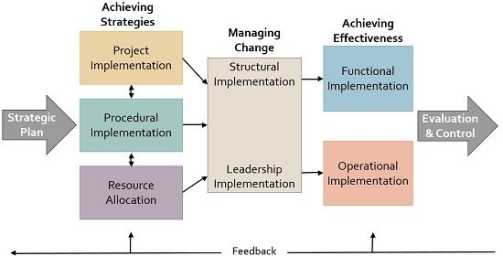
Strategy Implementation
Strategy implementation process
The strategy implementation process plays an important role in the success of the company. This process follows an environmental scan, SWOT analysis, and confirmation of strategic issues.
Prerequisites for strategy implementation
Strategy institutionalization: First of all, the strategy should be institutionalized in the sense that it should be promoted or defended in front of its members, as the person who assembled it may undermine it. is.
Developing an appropriate organizational culture:An organizational culture is an element of the internal environment that transforms objectives into results, such as cooperation, human resource development, degree of commitment and determination, and efficiency.
Develop an operational plan: An operational plan is an action plan, decision, and program that takes place on a regular basis at various parts of the company. When they are constructed to show the proposed strategic results, they help achieve the goals of the organization by focusing on the key elements.
Developing the right organizational structure:Organizational structure means how different parts of an organization are linked to each other. It emphasizes the relationships between various designations, positions, and roles. To implement the strategy, you need to design the structure according to the requirements of the strategy.
Regular Strategy Review: Strategy reviews are conducted on a regular basis to identify whether the strategy so implemented is relevant to the purpose of the organization. As an organization operates in a dynamic environment and is subject to change at any time, it is imperative to conduct a review to see if it can meet your organization's needs.
Even optimally formulated strategies will fail if not implemented in the right way. In addition, it should be noted that only effective implementation is possible if the strategy is consistent with other factors such as resource allocation, organizational structure, working environment, culture, processes and reward structure.
Strategy implementation aspects
Key takeaways:
References: